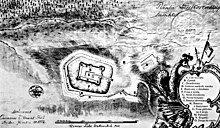You can help expand this article with text translated from the corresponding article in Polish. (August 2018) Click for important translation instructions.
|
| This article includes a list of references, related reading, or external links, but its sources remain unclear because it lacks inline citations. Please help improve this article by introducing more precise citations. (September 2013) (Learn how and when to remove this message) |
| Lanckorona Castle | |
|---|---|
 | |
| General information | |
| Architectural style | Polish Gothic |
| Town or city | Lanckorona |
| Country | Poland |
| Coordinates | 49°50′52″N 19°42′45″E / 49.8478°N 19.7124°E / 49.8478; 19.7124 |
| Construction started | 14th century |
| Completed | before 1330 |
| Demolished | 1655, 1771, 1870 |


The Lanckorona Castle (Polish: Zamek w Lanckoronie) was built in the early 14th century in Lanckorona, Poland. It was damaged in several fires and during conflicts, especially in 1655 during the Swedish Deluge and Battles of Lanckorona in 1771. Jakub Derc led a peasant revolt and was killed in Lanckorona.
History
As documented in the manuscripts of the chronicler and diplomat Jan Długosz, King Casimir III the Great erected the Lanckorona Castle to protect the road to Kraków and the border with the Duchy of Oświęcim.
Castle design
The original stronghold from the Middle Ages had a rectangular shape and had two four-sided corner towers. The rectangular inner courtyard was closed-off from the northwest side of the castle by a living quarters. In the 18th century, after the castle was rebuilt, cannon bastions were located in the corners of the castle, and a drawbridge led to the main gate. In 1770, the Bar Confederation repaired and fortified the castle. With the help of French engineers, external earth fortifications were built including a tick-shaped fort.
See also
References
Bibliography
- Władysław Konopczyński Bar Confederation (1936) ISBN 83-85218-07-6
This article about a castle in Poland is a stub. You can help Misplaced Pages by expanding it. |
